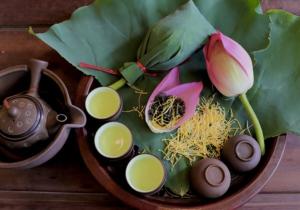Lan, tell us about your cultural experiences! March 2022 Issue
更新日:2022年4月27日
Vietnamese national flower
The cherry blossom, also known as sakura, is a symbolic flower in Japan. The beauty of the sakura attracts not only the Japanese but foreigners as well.
In Vietnam, there is a flower that is loved by people like sakura is in Japan. It is the lotus flower. Despite growing in the swamp, the lotus flower still blooms majestically, so it has been the beloved national flower for a long time. When they bloom in June, many people, especially young women, go to lotus ponds where they enjoy gazing at the lotus flowers and taking pictures while drinking lotus tea.
Just as Japanese people make good use of sakura in sweets and dishes, Vietnamese people also use the lotus flower in various ways. For example, lotus seeds are used as an ingredient in sweets and dishes and lotus leaves are used to wrap rice or steamed sticky rice to add fragrance. Recently, Vietnamese lotus tea has become known all over the world. It is said that lotus tea made from green tea with powdered lotus petals and stamens has a skin-beautifying effect, while lotus tea made from lotus seed cores can cure insomnia.
Isn’t it nice that our countries have flowers that we can be proud of within the world?

A lotus pond in Hanoi ハノイにある蓮の池

Lotus tea 蓮のお茶
ベトナムの国の花
日本の花と言えば桜です。桜の美しさは日本人だけでなく外国人の心も惹きます。
ベトナムには、日本の桜のように国民から愛されている花があります。それは蓮の花です。蓮は沼に生息しているにもかかわらず、堂々と綺麗に咲くので、国の花として古くから親しまれています。見頃の6月になると、若い女性を初め、多くの人は蓮の池に行き、蓮のお茶を飲みながら、蓮の花を観賞したり、写真を撮ったりして楽しんでいます。
日本人が桜をうまくお菓子や料理に活かしているのと同様に、ベトナム人も蓮の実をお菓子や料理の材料にしたり、蓮の葉でおこわやご飯を包み、香りを付けたりするなど、色々と活用しています。近頃では、ベトナムの蓮のお茶は世界でも知られるようになりました。蓮の花びらやおしべを粉末にして緑茶と練りこんだお茶は美肌効果があり、蓮の実の芯で作られたお茶は入眠効果があると言われています。
自分の国に、世界に誇れる花があるのは喜ばしいです。
Click to see the full catalogue of Lan's columns コラムの一覧へ


